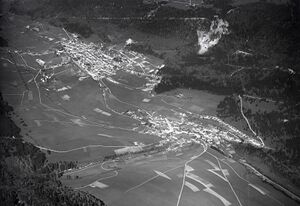Villeret
| Villeret |
|---|
 |
| Jura triangle / Canton Berne Bernese Jura / Vallon de Saint-Imier |
| Saint-Imier - Villeret - Cormoret |
Villeret is a village in the Vallon de Saint-Imier in the Bernese Jura, located just to the east of Saint-Imier. The village has a long history of watchmaking, longer even than the neighboring city, which continues to this day. Its name is integral to the brands Blancpain (which began there) and Minerva (now part of Montblanc) as well as historic ebauche maker Aurore.
Villeret Watchmaking in the 18th Century
Adam Bourquin (born October 20, 1735) set up a watchmaking workshop in Villeret in 1758, establishing business relationships with watchmakers in La Chaux-de-Fonds. The Bourquin family would later become famous for watchmaking, but this was a modest operation for the first decade or so. Young watchmaker David de la Reussille left Tramelan in 1765 for an apprenticeship with Bourquin, his uncle.
The three Frésard brothers (also called Frisard) settled in Villeret between 1765 and 1770 after their watchmaking apprenticeships. François (born in 1744), Jean-Henri (born in 1748), and the young Jacob (born in 1753) were joined by their three sisters, Madeleine, Elisabeth and Marianne, in Villeret. Together the Frésard family created "blanks", unfinished movement kits, which were sold around the world.
Jacob, the youngest, was also the most skilled. He began correspondence with the famous Jaquet-Droz family in La Chaux-de-Fonds and became a supplier to them. He was one of the craftsmen who created the famous automatons for Jaquet-Droz, and these became world famous. Jacob Frésard also invented his own ingenious mechanisms, including singing birds which were presented to Napoleon and Sélim, Sultan of Constantinople. But his craft was too good: He was driven out of the Turkish capital for his "demonic" creations. After a life of adventure, Jacob died in the Danubian principalities.
In 1778, the Frésard and Bourquin families began a partnership. Some stayed in Villeret to build watches while others traveled Europe to sell the company's creations. Josué Frésard traveled to Paris while Adam Bourquin (the grandson of the family's sire) was dispatched to Vienna. It was this combination of creation and sales that established Villeret as a watchmaking center in the 18th century.
By 1790 watchmaking reached a peak in Villeret, becoming the capital of the craft in the Vallon de Saint-Imier along with Sonvilier and Renan. Many case fitters settled in the town, including Jean-Frédéric Boissonnas of Geneva, Adolphe and Victor Frésard, Charles Jacot, and Frédéric Chopard. Watchmakers around the turn of the century in Villeret included David-Louis Bourquin (called "the younger"), who became well known as his sons traveled to France and Holland to sell. C.-E. Benoit, nephew of Josué Bourquin of Frisard & Bourquin, arrived around 1797, specializing in watches for Lille, Rouen, and Paris where his uncle lived. He also founded a workshop for the assembly of money boxes. Villeret also had two workshops for production of gold watch cases: Chopard (known as "le Petit") and that of Jean-Frédéric Boissonnas of Geneva.
The region was under French control, and all watches destined for France had to pass through a control and guarantee office in Saint-Imier. They were then taken to Porrentruy by a messenger named Marchand of Sonvilier where they were registered at the post office and sent on to the capitals of France.
Villeret Watchmaking in the 19th Century
Villeret also produced watches destined for Germany. David-Louis de la Reussille, Victor Bourquin-Beynon, and the famous house of Frédéric Blancpain (1786-1843) all focused on this market. Blancpain's family would continue as watchmakers for centuries, continuing without interruption longer than any other watchmaker. Frédéric Blancpain and these others specialized in so-called encounter wheel watches. These were cased in silver and were sold mostly through La Chaux-de-Fonds and in Savoy. His son, Emile Blancpain, added production of cylinder and anchor watches in 1851. On his death in 1857, his sons took over and, in 1864, began to produce watches with crown winding cased in gold and silver.
In the first half of the 19th century, 75% of the population of Villeret were involved in the production of encounter wheel watches, but this craft would be eliminated by 1865. The workers finished ebauches from the large Robert factory in Fontainemelon as well as the dominant Japy Frères factory in Beaucourt. Pinions came from local producers as well as producers in Montbéliard, while other components came from Tramelan, Cormoret, Courtelary, and Cortébert. Silver cases were produced in Breuleux, Saint-Imier, and Villeret, while cheaper metal cases came from Damprichard and towns along the Doubs river. Final assembly was handled in town or in Cormoret. The good quality and mechanical improvements made increased the wholesale price for a silver watch from under 20 francs to nearly 70 francs, and workers in the town could earn 20 to 25 francs per week. Most work still took place at home, with couriers transporting daily output around Villeret and to Les Breuleux and Tramelan.
Most cylinder watchmaking in town was still handled by the Bourquin (Lucien) and Frisard (Bertrand) families as well as by Albert Renard. The Blancpain family focused on anchor watches. In addition to Fontainemelon and Japy, anchor ebauches from Sonceboz and the Tavannes valley were used. Escapements were mainly produced in Val-de-Ruz and Cote-aux-Fees.
Watchmaking became more concentrated in the second half of the 19th century. While there were 20 manufacturers in Villeret in 1860, there were only 16 left in 1871 and only two by the turn of the 20th century!